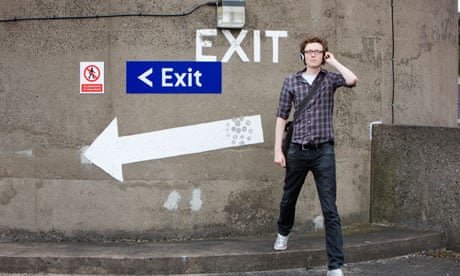Walking makes the ground feel needed. It's an aid to creativity, and you see the landscape in an entirely different way when you are on foot rather than on a bike, in a train or car. Whatever you pass through – whether it's the city, or an area of rugged natural beauty – starts to feel like a giant set. That blackbird, or the teeming passersby, seem like unpaid extras, and that sunset looks more dramatic than anything a set designer could possibly ever come up with.
So no wonder an increasing number of theatre-makers are creating performances based around walking, even though licensing them can be tricky (authorities tend to be concerned that distracted audiences might be run over – or worse).
The Australian piece En Route was a hit in Edinburgh this summer, and now London has both Accomplice, a treasure-hunt-style performance that takes you on a secret trail around Southwark; and Lovers Walk, a gently engaging guided tour of the sites of a love affair, which layers real places with fiction in an intriguing fashion.
This kind of show is not restricted to urban settings: earlier this summer, National Theatre Wales created For Mountain, Sand and Sea, a three-hour walk around the seaside town of Barmouth . And this week, Jack Scout, a walking performance created by artists Sap Dance and Louise Ann Wilson, takes intrepid audiences armed with stout pairs of walking boots through some of the hidden corners of Morecambe Bay, and across its treacherous sands.
Shows like these are not new. I recall with huge pleasure Fiona Templeton's YOU – The City from the 1980s, a citywide odyssey that was like falling down a rabbit hole into a parallel London. A few years back, the Glasgow-based group NVA took audiences up the Old Man of Storr and into hidden glens.
Louise Ann Wilson has also made several other walking-based shows, with the now-defunct company Wilson & Wilson. In Sheffield, they performed Mapping the Edge, an epic journey across the city by bus and tram; and in North Yorkshire, the hugely evocative Mulgrave, which explored the legends and stories connected with Mulgrave Woods. The social gamers Hide and Seek have, for their part, always seen the city as a playground, a place not just to work but also to play.
I recently heard an academic at a conference describing such theatre as a kind of plundering, in which the place is used as a resource for a spectacle. But I have no problems with such piracy, provided it's done well, with the piece genuinely rooted in its location, and turning the landscape and the topography into real players. The tension between performance and landscape can be a rich one, as Wildworks has often demonstrated in shows such as Souterrain, a version of Orpheus and Eurydice played out in villages around England and France. Lovers Walk also plays cleverly at the interface between real history and fiction, and between the solidity of buildings and the fleeting nature of love.
En Route was enjoyable, with its MP3 players offering endless commentary and a soundscape in your ear, but it never really convinced me that it was a journey into the heart of Edinburgh, rather than a journey into the self. I was so busy multi-tasking, I probably noticed less about the city than I would on a normal stroll. I could have been anywhere.
Part of the problem with Accomplice, besides the almost complete absence of dramaturgy, is that in giving you a fake purpose – clues to find and solve, rather like a child's trail around a museum – the city becomes a blur rather than a real player in your quest. The best part of the show, apart from the frequent stops for refreshment, came when we were taken past the extraordinary Crossbones graveyard. But was there really time to stand and stare at this piece of genuine history, with its hundreds of stories crying out to be told? No, because we had to hurry onwards in our entirely fake quest, at times literally walking round in circles. Wild goose chases can be terrific fun, but not when you start to feel like the goose.
One of the writers I'm currently mentoring (through a scheme with National Theatre Wales) recently discussed For Mountain, Sand and Sea, quoting Mark Twain on golf – he said it was "a good walk spoiled". The same might apply to any number of walking performances. Accomplice has the potential to combine theatre with adventure in an interesting way, but it mistakes novelty for innovation. As successful pieces of walking theatre, such as Mulgrave, have proved, it is the entire arc of the journey that matters, and not just the destination.
I'm beginning to think that the more portable such shows seem (both Accomplice and En Route have been performed in several cities), and the less they're genuinely rooted in a particular place, the less likely they are to offer a really satisfying perambulation. But, as ever, I could be way off beam – Lovers Walk began at the Brighton fringe, yet it still fits Southwark like a glove.

Comments (…)
Sign in or create your Guardian account to join the discussion